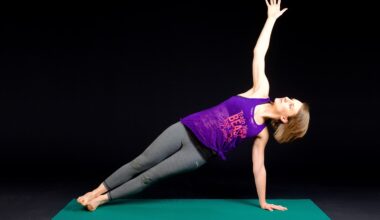How to Start a HIIT Program Safely
High-Intensity Interval Training (HIIT) is an effective workout method that alternates between short explosive bursts of high-intensity exercises and low-intensity recovery periods. For beginners, starting a HIIT program safely is crucial to avoid injuries and build a solid foundation. Before jumping in, it’s important to assess your current fitness level. If you’re new to exercise, beginning with fundamental movements can help improve your strength and endurance. Start with basic exercises such as squats, lunges, and push-ups. Once you feel comfortable, introduce interval training gradually. This approach allows your body to adapt to the demands of HIIT. It’s also essential to incorporate a proper warm-up before training sessions. Warming up increases blood flow, enhancing joint mobility and preparing your muscles for intense activity. Aim for at least 10-15 minutes of light cardio followed by dynamic stretches. Don’t forget to listen to your body during workouts. If something feels wrong or causes pain, stop immediately and reassess your technique. Progress slowly by increasing intensity and duration over time.
Choosing the Right Exercises
Selecting the right exercises is fundamental when starting your HIIT program. Focus on movements that utilize multiple muscle groups to maximize efficiency and results. Consider exercises like burpees, mountain climbers, and kettlebell swings. Try combining cardio movements like jumping jacks and high knees with strength workouts for balanced routines. Another key factor to consider is your personal preferences and fitness goals. Enjoying the exercises will help you stay motivated and committed. Feel free to experiment with different exercises to discover what works best for you. Aim for a mix of both aerobic and anaerobic exercises within your HIIT sessions. Proper technique is essential for preventing injuries, especially as you begin to increase intensity. For each exercise, practice good form before adding speed or resistance. Use resources like fitness apps or online videos to guide you on proper techniques. Seeking the advice of a trainer or fitness professional can also be beneficial. They can provide feedback and make sure you’re on the right track. A strong foundation sets the stage for greater advancements.
To establish a successful HIIT program, setting achievable goals and tracking progress is vital. Be specific about what you hope to accomplish, whether it’s losing weight, building muscle, improving endurance, or increasing overall fitness levels. Setting SMART (specific, measurable, achievable, relevant, and time-bound) goals can provide clarity and direction. Break down larger goals into smaller, manageable milestones that help maintain motivation throughout your journey. Keeping a workout journal can be an excellent way to record your routines and monitor your improvement over time. Include exercises performed, sets, repetitions, and any challenges faced. This reflection not only serves as motivation but also highlights areas needing improvement or adaptation. Stay accountable by sharing your progress with friends, family, or online communities. Social support is crucial in maintaining motivation and consistently following through on your program. You may also consider joining a local fitness group to enhance your experience. Surrounding yourself with like-minded individuals can provide you with encouragement on tough days. Ultimately, remember to celebrate every achievement, no matter how small.
Creating a Schedule
Establishing a consistent workout schedule is important for sustaining momentum in your HIIT program. Choose specific days and times that align with your personal schedule to ensure you can stick with it long-term. Aim for 2-3 sessions per week, allowing for proper recovery between workouts. As you progress, you can gradually increase the frequency. Incorporating short, HIIT sessions into your weekly routine is manageable compared to longer workouts. Typically, 20-30 minutes of intense activity can be very effective. Consider alternating between HIIT and lower-intensity workouts like steady-state cardio or strength training for overall fitness. Mark your schedule with workout days and times to reinforce your commitment. It can be helpful to treat your workout sessions like important appointments. Setting reminders on your calendar can keep you accountable. Don’t forget to adapt your schedule as necessary to maintain balance in other areas of your life, such as work and family. Flexibility in your training program is essential for overall success. Staying committed while allowing yourself the freedom to adjust will lead to long-lasting habits.
Incorporating rest and recovery time into your HIIT program is critical for overall performance and injury prevention. High-intensity workouts place significant stress on your body, requiring adequate recovery to rebuild and strengthen muscles. Aim for at least one full rest day per week to allow your body time to recuperate. Listen to your body and prioritize rest when you feel fatigued or notice decreased performance. Recovery techniques such as stretching, foam rolling, or light walking are great for alleviating soreness and improving flexibility. Hydration also plays a significant role in recovery; drink plenty of water before, during, and after your workouts. Additionally, proper nutrition is vital for fueling your body and aiding recovery. Focus on a well-balanced diet rich in protein, healthy fats, fruits, and vegetables to support your fitness goals. Consider consulting with a nutritionist or dietitian to develop a personalized eating plan to supplement your exercise routine. Strategic planning around both workouts and recovery helps ensure a healthy and productive approach to your HIIT journey. Make it a point to prioritize recovery alongside your training.
Staying Motivated
Staying motivated throughout your HIIT program can be challenging, especially during the initial stages. Set up a motivating environment for workouts by creating a dedicated space or selecting an inspiring location. Use motivational quotes or images around you to remind yourself of your goals and purpose. Another effective technique is to incorporate variety into your routines. Repeating the same exercises can lead to boredom, so continually explore new drills or formats to keep things interesting. Joining group classes can also boost motivation and commitment; workout partners provide support and accountability, making training enjoyable. Tracking progress, as previously mentioned, will keep your motivation alive. Seeing tangible improvements creates a reinforcement loop. Establishing a playlist of your favorite high-energy songs can elevate your mood and enhance your workouts. Alternatively, podcasts or audiobooks can make your sessions feel less daunting and more engaging. Celebrate small victories along the way, as positive reinforcement can fuel motivation. Building a reward system, where you treat yourself after achieving milestones, is another great way to enhance your journey and sustain enthusiasm.
As you progress with your HIIT program, consider periodically reassessing your workout plans. Your body adapts to training, making it essential to enhance your routines to continue improving results. Taking time to evaluate your goals, achievements, and challenges will help you identify areas for growth. If you’ve reached your initial targets, don’t hesitate to set new, more ambitious objectives. Explore challenges such as timed intervals or increased reps to push your limits. Additionally, vary your workouts by incorporating new exercises or training methods to prevent plateaus. Experimenting with different formats, like circuit training, can provide variety while maintaining intensity. Consulting fitness professionals for guidance and feedback can help to refine techniques and ensure you’re on the right path. They can help you realize your potential with advanced training advice specific to your goals. Periodic assessments keep you engaged and focused on self-improvement. As you progress, embracing the journey and all challenges will cultivate a lifelong appreciation for health and fitness. Remember, consistency and adaptability are keys to long-term success in your HIIT program.
Your wellness journey through HIIT is not only about physical transformation but also a comprehensive approach that reinforces your commitment to health. Focus on maintaining positivity throughout your exercise regimen. Emphasizing mental health and self-care along with fitness routines can enhance your overall happiness. Ensure you incorporate mindfulness practices, such as meditation or deep breathing exercises, post-workout, to promote relaxation and mental clarity. Evaluate your motivations for beginning HIIT and keep them at the forefront. Surrounding yourself with supportive friends, whether in person or online, can create an uplifting environment. Sharing your goals with them can lead to accountability as well as encouragement. Celebrate every part of your journey, recognizing that fitness is not a destination but an ongoing process. By embracing each step along the way, you’ll cultivate a sustainable approach to health that can carry you long beyond your HIIT program. The right mindset will aid transformation beyond physical appearances – it also contributes to emotional resilience. Ultimately, the foundation you build through HIIT can lead to a healthier lifestyle, shaping other aspects of life positively and empowering you to thrive.


